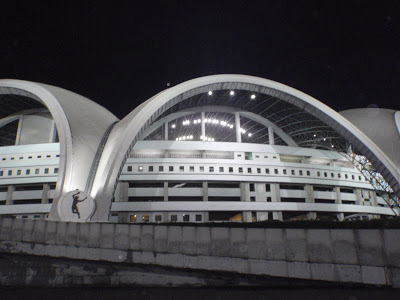For our second trip to Thailand we flew directly to Phuket from Seoul. As this was to be a diving trip, we then headed about an hour up the coast to Khao Lak, in Phang Nga Province. We were staying for a week, and we'd be taking a 3-day liveaboard to the Similan Islands with Wicked Diving.
 |
| our accommodation in Khao Lak |
However the weather decided differently. Normally the rainy season is finished by late October, and this was early November. However a bad weather system blew in, and our liveaboard had to be cancelled. You can see from the photos that the weather was quite cloudy (when it wasn't rainy).
 |
| fishing boat coming back to port because of the storm |
We actually got to embark on our liveaboard, but as the authorities had closed the Similan Islands and the fishing boats were coming back to port because the weather was so bad it was decided to cancel our trip for obvious reasons.
 |
| fishing boats, Khao Lak port |
 |
| beach, Khao Lak |
So we visited the surrounding area, including a waterfall near Khao Lak where I got bitten by leeches for the first (and hopefully last?) time in my life!
 |
| waterfall, near Khao Lak |
We also visited a rubber plantation. Rubber is harvested mainly in the form of latex.
 |
| a plantation of rubber trees |
The sticky, milky latex is drawn off by making incisions into the bark and collecting the fluid in vessels. This process is called "tapping". The latex then is refined into rubber ready for commercial processing.
 |
| collecting the latex from a rubber tree |
When the 2004 tsunami struck South Asia, the Khao Lak region was the hardest-hit area in Thailand with over 4,000 deaths, more than 3,000 who were never accounted for, and thousands who were injured. It has since made an impressive recovery and is once again a popular tourist destination.
 |
| shrine |
 |
| this little fellow looks like he's wearing a bow tie! |
To compensate for not diving the Similan Islands, Wicked Diving suggested going to Chiaw Lan Lake in Khao Sok National Park for two days diving.
 |
| 'Unique diving in a jungle paradise' - Khao Lak (source) |
This was only the second time I'd dived in fresh water - the first time was in Lake Baikal in Siberia.
 |
| source |
At 739 km2, Khao Sok NP is Thailand's largest protected area. It comprises the largest area of virgin forest in Southern Thailand and is a remnant of rainforest which is older and more diverse than the Amazon Rainforest.
 |
| limestone cliffs at Khao Sok |
The park is famous for having the enormous Rafflesia flower, but unfortunately none were flowering while we were there.
 |
| limestone cliffs, Khao Sok |
Chiaw Lan is in fact an enormous man-made reservoir and diving there is a very eerie experience - visibility is low (you need a torch even in broad daylight) and you can suddenly find yourself face to face with submerged tree branches with little warning.
 |
| decorations on long-tail boats |
Our transport across and round the lake was by long-tail boat, which gets its name from the trailing drive shaft and propeller at the back. The garlands and scarves that decorate the bow are there to provide good luck and protection - we had to be careful not to step on them or it would offend the spirits.
 |
| decorations on long-tail boats |
We did three dives (at Peter Pan Cave, Catfish Cave and another spot with no name), at an average depth of 12-13 metres, although the lake is at least 60 metres deep. Wildlife underwater was fairly limited - we mainly saw catfish.
Our accommodation was at a floating village on the lake, from where we could hear gibbons.
The final day of our trip was spent exploring Phuket before our late evening flight. Phuket is Thailand's largest island, and is connected to the mainland by road bridges. Some of the resorts have the reputation as party centres - a very different atmosphere from the quieter Khao Lak.
 |
| temple, Phuket |
We finished the day with cocktails at the Evason Phuket, which I was curious to visit as I've stayed in two of their sister resorts (Soneva Fushi and Soneva Gili) in the Maldives.
 |
| sunset at the infinity pool, Evason Phuket |
If you enjoyed this post you might also like:
- Birthday in Bangkok - our first trip to Thailand.


































